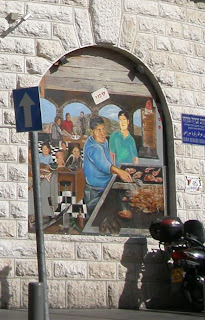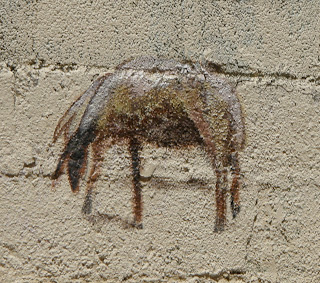LENS ON A FERTILE LAND, ISRAEL - photography
A photo-blog that tells of the beauty of Israel and her people. רימונה טראוב - צילום - ארץ ישראל, Photography - Rimonah Traub
Wadi Kelt - 2010 - The River Pratt

Wadi Kelt - 2010 - The River Pratt
October 17, 2014
October 31, 2012
Gates of Jerusalem - Old City שערי ירושלים
Jerusalem - Old City Walls
Built between 1537 - 1541, by Ottoman Sultan, Suleiman the Magnificent (1520 - 1566).
The walls are built on the remains of ancient walls and stretch for approximately 4.5 kilometers.
They vary in height from 5 - 15 meters with a thickness of 3 meters.
The walls contain 43 surveillance towers and 11 gates, 7 of which are presently open.
 Lion's Gate - שער האריות known also as St. Stephen's Gate and Sheep Gate
Lion's Gate - שער האריות known also as St. Stephen's Gate and Sheep Gate
Situated on the east side of the old city walls and built by Suleiman the Magnificent.
The Arabic name is Bab Sittna Miniam, Gate of Our Lady, due to its proximity to the place where according to Christian belief, the Virgin Mary was born. Also called the St. Stephen's Gate by Christians, which was in actuality an earlier gate built on the same location.
Of much interest are the panthers (often mistaken for lions, cheetahs or leopards), which are found on either side of the gate.
The panthers are the emblem of the Mameluke Sultan Baybars (1260 - 1277), who was one of the Mameluke leaders that ruled the Holy-land between 1291-1516).
With the fall of Acre, in 1251 the Mamelukes were responsible for the eviction of the Crusaders from the land.
For Jews, this gate represents the unification of Jerusalem, as it was through this gate that the 55th Paratroop Brigade entered the Old City during the 6 day war, thereby liberating and unifying Jerusalem, once more.
Sha'ar Harachamim - Gates of Mercy, Golden Gate, שער הרחמים
Situated on the eastern side of the city walls. Built either by the Byzantines during Justinian's rule (527 to 565 CE) or during the Ymmayad Period (661-750), using Byzantine workers.
The gate is made up of two blocked archways, the southern arch is know as Sha'ar Harachmim, Gates of Mercy, שער הרחמים the northern arch is known as Shaa'ar Hatshuvah, שער תשובה Gates of Repentance. The Arabs adopted the name Gates of Mercy, which translates as Bab Al-Rahma. Whilst Christians refer to them as the Golden or the Beautiful gate.
Many reasons have been forwarded, as to why these gates, which lead to the Temple Mount and Temple entrance, are blocked. Some theorists believe that the Fatimids blocked them for security reasons. Others believe that the opponents of Judaism blocked the gates to prevent the realization of the Judaic belief, that the Jewish Messiah will enter the Temple Mount through these gates. The placement of a Muslim cemetery in front of the gates would reinforce the later theory, as a Cohen, (priest) cannot walk through a cemetery. However according to Jewish belief the Messiah comes from the house of David, and is not a Cohen (priest). In addition the ruling that a Cohen cannot walk through a cemetery, applies only to a Jewish cemetery.
*********
Dung Gate (Sha'ar Ha'ashpot, Gate of Silwan) שער האשפות
Situated on the south-east side of the city walls and built by Suleiman the Magnificent between 1537 to 1541.
Two theories have been forwarded as to why this gate is called Dung Gate. The first suggests that it was the place where garbage was deposited after the Second Temple destruction in 70 CE.
The name, Gate of Silwan, derives its name from the village of Silwan, which can be seen on the eastern side of the Kidron Valley.
Tanner's Gate Sha’ar HaBurskai שער הבורסקאים
A minor gate situated just west of Dung Gate, on the southern wall. So named, as it it served as an entrance gate to the local tanneries, existent during the Crusader Period, (199 - 1291).
Zion Gate - שער ציון - Bab an-Nabe Dawud
Facing Mount Zion and Hebron, which is to the south of Jerusalem. Situated on the southern side of the city walls, it sits on the apex of Mount Zion, so that half of Mount Zion is within the city walls and remaining half, outside of the city walls. Built by Sultan Suleiman the Magnificent between 1537 and 1541. This gate serves as an entrance point to both the Jewish and Armenian Quarters.
Jaffa Gate - שער יפו, Sha'ar Yafo - David's Gate, Bab el-Khalil (Gate of the Friend) and Bab Mihrab Daud, (Gate of the Prayer Niche of David)
Situated on the west side of the city walls and built by Suleiman the Magnificent between 1537 and 1541. In Arabic the gate is know as Bab Al-Halil (Hebron Gate), as it leads to Hebron where Abraham is buried. Halil, besides being Arabic for Hebron, also means beloved one, hence the gate is also know as the Gate of the Beloved, referring to Abraham, the beloved of God. Because of its proximity to David's Tower (Migdal David), the gate is also known as Gate of the Prayer Niche of David. The Crusaders having adopted the later name, called it Porta Davidi. It is an access point to the Christian, Muslim and Armenian Quarters.The opening alongside Jaffa gate was created to allow Kaiser Wilhelm the Second, to enter Jerusalem in a carriage, when he visited in 1898.
The New Gate, HaSha'ar HaChadash השער החדש, know in Arabic as Bab Al-Jedid,
or Gate of Hamid
The newest gate situated on the North West corner of the city wall. Built by the Turkish Sultan Abdul Hamid The Second, in 1887 to provide direct access into the Christian Quarter.
Flower Gate Herod's Gate - Sha'ar HaPrachim - Sheep's Gate, Bab - Al - Sahira, Jeremiah's Den Gate - שער הפרחים
The Flower gate is situated on the northeastern side of the city walls. The gate takes it name from the floral motifs on the gate's facade.
Previously known as Bab- Al Sharia, in Arabic. (Gate of the Cemetery), but changed to Bab Al Zahira, meaning Gate of Flowers.
Named Herod's gate after either Herod the Great, or Herod Antipas, (his son).
Also known as Jeremiah's Den, as it is said that Jeremiah was imprisoned nearby.

Damascus Gate known as Shechem Gate / Nablus Gate / Bab-Al-Amud שער שכם
Damascus gate is situated at the northern point of the upper and lower cardo.
Roman Emperor Hadrian 117 to 138 CE built a Triumphal Arch beneath the present gate, of which one arch is visible. Hadrian also erected a victory column in front the arches. Hence the Arab name, Bab-Al-Amud, This column is depicted on the Madaba map. The arches are built with secondary stones probably taken from the Temple Mount.
This was the Northern entrance to Jerusalem during the Crusader period 1099 to 1291 CE.
The Madaba Map
The Madaba map is a Byzantine Period (824-640), mosaic floor found in Jordan at St. George Church in Madaba - (discovered in 1884).
Originally measures 21 x 7 meters in size. It depicts, Lebanon, The Nile Delta,
the Mediterranean, Mo-ab desert, the Dead Sea, Bethlehem and bridges over the Jordan River.
Shown above, is a modern day copy of the mosaic, (which is found in the Cardo, in the Jewish section of the Old City). This shows the most detailed part of the original map,displaying the Damascus Gate, Lions Gate, Golden Gate and Zion Gate, Church of the Holy Sepulcher, Tower of David, the Cardo and the Decamanus and New Church.
See link to;
Antique Photos: The Gates of the Old City of Jerusalem ;
http://virtualjerusalem.com/judaism.php?Itemid=13034

October 29, 2012
Jerusalem - Wall Mural IV - Street Art - Paintings on Buildings - ירושלים - ציורי קיר
Corner of Agripas and Sukkat Shalom Streets
Muslim Section - Old City Jerusalem
Hadekel Street - Tabla Rosa Jerusalem Municipality Street Art Project
Market Scene off the Davidson Center, in front of Tanners / Bursky Gate - Old City Jerusalem
For more Wall Art on Lens on a Fertile Land; -
Jerusalem - Wall Mural I -Paintings on Buildings - ירושלים - ציורי קיר
http://israelcamerafocus.blogspot.co.il/2010/08/murial-painting-buildings-of-jerusalem.html
Jerusalem - Wall murals II - Paintins on Bulletproof Concrete - Gilo (South Jerusalem) ציורי קיר, גילה שכונה בדרום ירושלים - Paintings on Walls
Jerusalem - Wall Murals III - Paintings on Buildings - Old Railway Station - September 2010 - ירושלים, ציורי קיר תחנת הרכבת הישנה
http://israelcamerafocus.blogspot.co.il/2010/09/wall-murals-ii-jerusalem-old-railway.html
March 29, 2012
Machtesh Ramon מכתש רמון - 2012
The deepest point of the crater is Ein Saharonim עין סהרונים, the makhtesh's only natural water source.
The machtesh and the surrounding area forms Israel's largest national park, the Ramon Nature Reserve.
The town of Mitzpe Ramon מצפה רמון, "Ramon Observation Point" is located on the northern edge of the crater.
The Carpentry Shop - המנסרה
Found in the center of Makhtesh Ramon - Ha-Minsara (The Carpentry Shop), formed as a result of a magma flow, that melted the existing sandstone. As the liquefied sand slowly consolidated, it formed into blocks of quartzite stone.
The INPA Ramon Visitors Center
Subscribe to:
Comments (Atom)
Off the Shores of the Red Sea












+Bab+Harat+al-Yahud+Jewish+Quarter+Gate+Bab+an-Nabi+Dawud+Prophet+David+Gate.JPG)















































